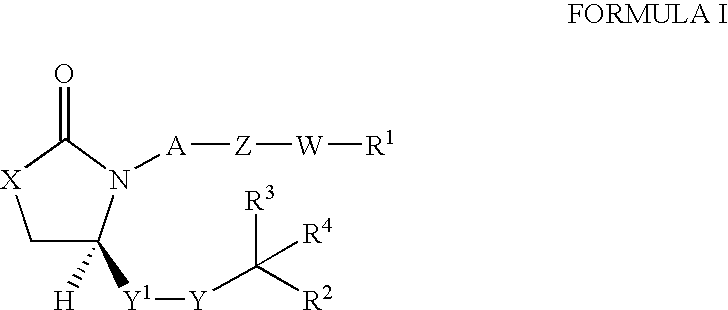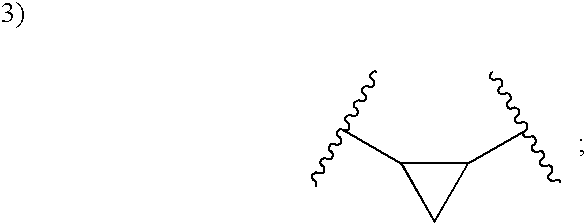Oxazolidin-2-one and thiazolidin-2-one derivatives for use as EP4 receptor agonists in the treatment of glaucoma
a technology of ep4 receptor and oxazolidin, which is applied in the direction of biocide, group 5/15 element organic compounds, drug compositions, etc., can solve the problems of unsatisfactory first-line drugs, and many of the drugs formerly used to treat glaucoma proved unsatisfactory, etc., to achieve the effect of elevating intraocular pressur
- Summary
- Abstract
- Description
- Claims
- Application Information
AI Technical Summary
Benefits of technology
Problems solved by technology
Method used
Image
Examples
example 1
7-{4-[(1E,3S)-3-hydroxy-4-phenylbut-1-enyl]-2-oxo-1,3-oxazolidin-3-yl}heptanoic acid (1-10) and 7-{4-[(1E,3R)-3-hydroxy-4-phenylbut-1-enyl]-2-oxo-1,3-oxazolidin-3-yl}heptanoic acid (1-11)
Step 1: 4-methoxycarbonyloxazolidin-2-one (1-1)
[0337]The preparation of 1-1 was carried out according to the literature procedure (see: Sibi, M. P. et al, J. Chem. Soc. Perkin Trans. 1 1994, 1675). Thus, 39.5 grams of serine methyl ester hydrochloride was reacted with phosgene (20% solution in toluene, 175 mL) to give 42 grams of desired product. 1H NMR (400 MHz, acetone-d6): δ 7.1 (br s, 1H, NH), 4.64–4.56 (m, 2H), 4.44 (dd, 1H), 3.77 (s, 3H).
Step 2: N-Boc4-methoxycarbonyloxazolidin-2-one (1-2)
[0338]The preparation of this compound was carried out according to the method described by Ishizuka and Kunieda (see: Tetrahedron Lett. 1987, 28, 4185). Thus, to a solution of 1-1 (1 g, 6.9 mmol) in THF was added di-t-butyl dicarbonate (1.81 g), triethylamine (1.16 mL) and DMAP (84 mg). The solution was stir...
example 2
(4S)-4-[(1E,3R)-4,4-difluoro-3-hydroxy-4-phenylbut-1-enyl]-3-[6-(1H-tetraazol-5-yl)hexyl]-1,3-oxazolidin-2-one (2-8) and (4S)-4-[(1E,3S)-4,4-difluoro-3-hydroxy-4-phenylbut-1-enyl]-3-[6-(1H-tetraazol-5-yl)hexyl]-1,3-oxazolidin-2-one (2-9)
Step 1: methyl N-(6-cyanohexyl)-D-serinate (2-1)
[0345]To a solution of D-serine methyl ester hydrochloride (0.91 g) in ethanol (18 mL) was added 7-oxoheptanenitrile (0.67 g) and triethylamine (0.6 mL) (see: Kubodera, N. et al, Heterocycles 1982, 19, 1285) and the mixture was stirred under N2 for 1 h. To the solution was then added Na(CN)BH3 (0.4 g) and the resultant cloudy suspension was further stirred under N2 for 1 h. The mixture was quenched with water and concentrated in vacuo and the residue diluted with ethyl acetate / saturated NaHCO3. The organic layer was separated and the aqueous layer extracted with ethyl acetate (3×). The organic layers were washed with water, brine, dried over Na2SO4 and filtered. The filtrate was concentrated and the res...
example 3
7-{(4S)-4-[(1E)-3-hydroxy-4-phenylbut-1-enyl]-2-oxo-1,3-thiazolidin-3-yl}heptanoic acid (3-9)
Step 1: ethyl D-cysteinate (3-1):
[0351]To a solution of D-cysteine (12 g) in 200 mL anhydrous ethanol was bubbled in anhydrous hydrogen chloride for 15 minutes. The solution was allowed to stir at room temperature overnight afterwhich it was concentrated in vacuo to yield 13 g (93%) of 3-1 as a white solid whose 1H NMR data was identical to that reported in the literature.
Step 2: ethyl(4R)-2-oxo-1,3-thiazolidine-4-carboxylate (3-2):
[0352]To a solution of 3-1 (8.5 g, 22.6 mmol) in 200 mL THF was added of carbonyl diimidazole (12.5 g) and the solution was stirred overnight at room temperature. The solution was concentrated in vacuo, 200 mL of 5% Na2CO3 was added and the solution stirred for one hour whereupon 6M HCl was added until the pH of the solution remained at 2. The solution was extracted with EtOAc, the organic phases were then combined, dried over MgSO4, filtered and concentrated in v...
PUM
| Property | Measurement | Unit |
|---|---|---|
| temperature | aaaaa | aaaaa |
| temperature | aaaaa | aaaaa |
| temperature | aaaaa | aaaaa |
Abstract
Description
Claims
Application Information
 Login to View More
Login to View More - R&D
- Intellectual Property
- Life Sciences
- Materials
- Tech Scout
- Unparalleled Data Quality
- Higher Quality Content
- 60% Fewer Hallucinations
Browse by: Latest US Patents, China's latest patents, Technical Efficacy Thesaurus, Application Domain, Technology Topic, Popular Technical Reports.
© 2025 PatSnap. All rights reserved.Legal|Privacy policy|Modern Slavery Act Transparency Statement|Sitemap|About US| Contact US: help@patsnap.com



